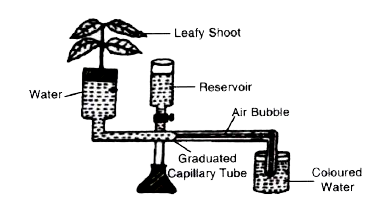Bulk of water requirement of plant is met through the process of
(a) active absorption
(b) passive absorption
(c) root pressure
(d) imbibition
The correct Answer is:B
Step-by-Step Solution:
1. Understanding Water Absorption in Plants:
- Plants require water for various physiological processes, and they absorb water primarily through their roots.
2. Types of Water Absorption:
- There are two main types of water absorption in plants: active absorption and passive absorption.
- Active Absorption: This process involves the use of energy (ATP) generated from root respiration. It occurs against the concentration gradient, meaning that roots actively take up water from the soil even when the concentration of water is lower in the roots than in the surrounding soil.
- Passive Absorption: This process does not require energy. Instead, it relies on the transpiration pull created by the loss of water vapor from the leaves. As water evaporates from the leaf surface, it creates a negative pressure that pulls more water up from the roots through the xylem.
3. Comparison of Active and Passive Absorption:
- Energy Requirement: Active absorption requires ATP, while passive absorption does not.
- Rate of Absorption: The rate of water absorption is generally higher in passive absorption due to the continuous transpiration process, whereas active absorption has a slower rate.
4. Conclusion:
- Given that the question asks for the process through which the bulk of water requirement of plants is met, the answer is passive absorption. This is because it is more efficient and does not require energy expenditure from the plant.
5. Final Answer:
- The bulk of water requirement of plants is met through the process of passive absorption.
---
- Plants require water for various physiological processes, and they absorb water primarily through their roots.
- There are two main types of water absorption in plants: active absorption and passive absorption.
- Active Absorption: This process involves the use of energy (ATP) generated from root respiration. It occurs against the concentration gradient, meaning that roots actively take up water from the soil even when the concentration of water is lower in the roots than in the surrounding soil.
- Passive Absorption: This process does not require energy. Instead, it relies on the transpiration pull created by the loss of water vapor from the leaves. As water evaporates from the leaf surface, it creates a negative pressure that pulls more water up from the roots through the xylem.
- Energy Requirement: Active absorption requires ATP, while passive absorption does not.
- Rate of Absorption: The rate of water absorption is generally higher in passive absorption due to the continuous transpiration process, whereas active absorption has a slower rate.
- Given that the question asks for the process through which the bulk of water requirement of plants is met, the answer is passive absorption. This is because it is more efficient and does not require energy expenditure from the plant.
- The bulk of water requirement of plants is met through the process of passive absorption.
Topper's Solved these Questions
Similar Questions
Knowledge Check
Study the diagram of plant cell where water passes through the cell wall and answer the questions that follow :

Water regulation within the plant cell occurs through the process:AOsmosisBDiffusionCActive transportDTranspirationLeguminous plants are able to fix atmospheric nitrogen through the process of symbiotic nitrogen fixation. Which one of the following statements is not correct for this process of nitrogen fixation ?
ALeghaemoglobin scavenges oxygen and is pinkish in colourBNodules acts as sites for nitrogen fixationCThe enzyme nitrogenase catalyses the conversion of atmospheric N2 to NH3DNitrogenase is insensitive to oxygen
Water ascends in plants through
View SolutionLeguminous plants are able to fix atmospheric nitrogen through the process of symbiotic nitrogen fixation. Which one of the following statements is not correct for this process of nitrogen fixation ?
View SolutionLeguminous plants are able to fix atmospheric nitrogen through the process of symbiotic nitrogen fixation. Which one of the following statements is not correct during this process of nitrogen fixation?
View SolutionWater requirement of Kangaroo/Desert Rat is largely met by
View SolutionThe diagram of an apparatus given below demonstrates a particular process in plants. Study the same and answer the questions that follow :

Name the structures in a plant through which the above process takes place.
View SolutionThe animal capable of meeting all water requirements through oxidation of its internal fat is
View Solution
